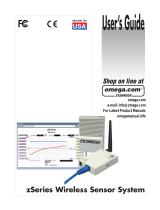
I
Introduction
Thank you for purchasing a compact thermal image sensor. In order to use this product safely,
please read this instruction manual completely before use and confirm the correct handling and
instructions. In addition, please retain this instruction manual for future reference.
Before using
Please confirm the contents of packing. If something is missing, please contact your nearest
distributor.
Names Quantity
Compact thermal image sensor 1
Custom Power/Alarm output cable 1
Custom Network cable 1
Universal head 1
Lens cap 1
Connector cap 1
Mounting screw (already mounted to the product) 1
Application software (CD)
Instruction manual (Sensor/application software) (CD)
1
Power supply w/cable 2.5 m (8.2 ft)
Quick manual
1
1
About this instruction manual
Under absolutely no circumstances may the contents of this instruction manual, in part or in
whole, be transcribed or copied without permission.
The contents in this instruction manual are subject to change without notice in future.
The figures in this instruction manual may be emphasized, simplified or omitted.
Every effort has been made to ensure that the details of this manual are accurate. However,
should any errors be found or important information be omitted, please inform your nearest
distributor.
The company names and brand names used in this manual are the trademarks or registered
trademarks of respective companies.
About exemption from responsibility
Unless otherwise specified in the guarantee clauses, we do not offer any guarantee about
this product.
We shall not be liable to a customer or a third party for any damages or indirect damages by
using this product or by unpredictable defects of the product.
Hardware requirements
Compatible PC : DOS/V compatible
* .NET Framework 2.0 or later has been installed and runs correctly.
* Display resolution: 800 x 600 pixels or more (recommended)
OS : Windows 2000 (SP4 or later)/XP/Vista_(Windows XP or later recommended)
* .NET Framework 2.0 or later (required)
Communication port : LAN
Hard disk : 150MB or more free space for installation
Memory : Windows 2000/XP … 1GB recommended (512MB or more)
: Windows Vista … 2GB or more recommended
CPU : Windows 2000/XP … 1.5GHz or faster recommended
: Windows Vista_… 2GHz or faster recommended
• “
Microsoft” and “Windows” are either trademarks or registered trademarks of Microsoft
Corporation, USA.
• “Intel” and “Pentium” are either trademarks or registered trademarks of Intel Corporation, USA.























